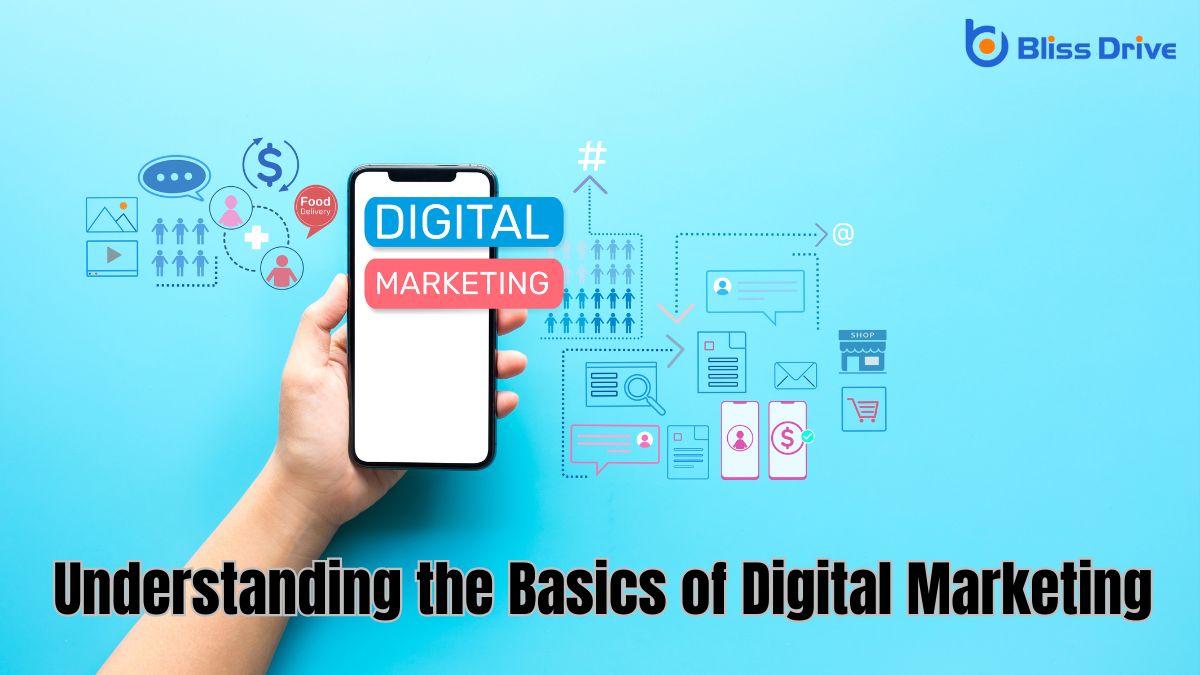PRICING
SERVICES
DIGITAL MARKETING SERVICES
COMPETITIVE ANALYSISSEO SERVICESCONVERSION RATE OPTIMIZATIONWEB DESIGNCONTENT MARKETINGPAY PER CLICKRESOURCES
When we’re new to digital marketing, it’s often best to start with content marketing. It’s a great way to develop valuable and engaging content that connects with our audience without needing complex technical skills. By sharpening our storytelling and understanding what our audience loves, we lay the groundwork for success. Plus, content marketing easily integrates with platforms like social media and email. Curious to explore more avenues in digital marketing? Let's keep going.

Digital marketing is a dynamic and essential component of modern business strategy. As we begin our journey into this field, it’s important that we grasp the basics. Digital marketing involves promoting products or services through digital channels like search engines, email, websites, and mobile apps. These channels help us reach a wider audience effectively and efficiently.
Understanding key concepts such as search engine optimization (SEO), content creation, and email marketing is fundamental. SEO improves our visibility on search engines, while engaging content attracts and retains customers.
Email marketing allows us to communicate directly with our audience. By mastering these fundamentals, we can tailor our strategies to meet our goals and connect with our audience meaningfully.
Let’s dive deeper into these elements, ensuring we’re well-prepared for success.
Let's explore how social media marketing can help us build brand awareness and engage with our target audience.
By crafting compelling content and interacting with followers, we can create a community that feels connected to our brand.
Together, we'll discover strategies to maximize our presence on various platforms and effectively reach those who matter most.
When it comes to building brand awareness, exploring social media marketing can be a game-changer. We've got a powerful tool at our fingertips that lets us connect with audiences in a direct and personal way.
Social media platforms like Facebook, Instagram, and Twitter provide us with the opportunity to showcase our brand's personality and values. By sharing engaging content, we can reach potential customers who mightn't have found us otherwise.
Let's focus on creating a consistent brand image across all platforms. This means using the same logo, color scheme, and tone of voice. It helps our audience recognize and remember us.
Additionally, leveraging analytics tools allows us to track our progress and adjust strategies as needed. Social media marketing is an accessible and impactful way to grow our brand.
How do we truly engage our target audience on social media? First, we need to understand their preferences and interests. By analyzing insights and feedback, we can tailor our content to align with what our audience values.
It's essential to create interactive content—like polls, quizzes, and live Q&A sessions—that invites participation and fosters a sense of community.
Next, we should maintain a consistent and authentic voice. Let's communicate our brand's personality in a way that resonates with our audience. Engaging visuals and storytelling can capture attention and encourage sharing.
Lastly, responding promptly to comments and messages builds trust and shows that we value their input. By doing this, we create stronger relationships and a more engaged community.
Let's kick off our content marketing journey by first understanding what our audience truly wants.
Once we comprehend their preferences, we can focus on crafting engaging content that captures their interest.
Finally, we'll explore effective channels to promote our content and reach our target audience.
To effectively engage in content marketing, it's crucial to understand our audience's preferences, as this insight guides us in creating relevant and compelling content.
We need to ask ourselves: What topics resonate with them? Which formats do they prefer? Are they more inclined to read blogs, watch videos, or engage with infographics? By analyzing data from social media interactions, surveys, and website analytics, we can identify patterns and trends in their behavior.
Let's pay close attention to feedback and comments, as they often reveal valuable insights into what our audience truly desires.
Understanding these preferences allows us to tailor our content strategy to meet their needs, ensuring that we provide value and foster a connection. This understanding is the foundation for successful content marketing.
Crafting engaging content is an art and a science that demands creativity and strategic thinking.
When we explore content marketing, we need to focus on connecting with our audience in meaningful ways.
Let's break it down into key elements that can guide us:
When starting on the journey of content marketing, choosing the right channels is essential to reaching our audience effectively. We need to evaluate where our audience spends their time. Are they scrolling through social media, checking emails, or watching videos on YouTube?
Each platform has its strengths. Social media offers quick engagement and shareability, while email provides a more personal touch. Video platforms allow us to convey complex ideas visually.
Let’s not forget about blogs and podcasts, which are excellent for building authority and providing in-depth knowledge. By testing a few channels, we can determine which ones yield the best results.
Analytics tools help us track performance, allowing us to refine our strategy. Ultimately, the right mix of channels maximizes our content’s impact.
Despite the rise of new digital platforms, email marketing remains a powerhouse in reaching and engaging audiences effectively.
We've found that it offers a direct line to potential customers, often leading to higher conversion rates.
Let's explore why email marketing is so effective for beginners:
Understanding the basics of Search Engine Optimization (SEO) is essential for anyone looking to enhance their online presence. SEO helps us improve our website’s visibility on search engines like Google. By optimizing our content, we can attract more visitors and potential customers.
The key involves using relevant keywords, creating quality content, and guaranteeing our website is user-friendly.
Let’s focus on keyword research first. We need to identify the terms potential customers use when searching for products or services like ours. Once we’ve got a list, we can incorporate these keywords naturally into our content.
Next, let’s guarantee our website is easy to navigate and mobile-friendly. Search engines prioritize user experience, so a well-structured site ranks higher.
With SEO, we’ll increase our chances of being discovered.
While mastering SEO is essential, leveraging Pay-Per-Click (PPC) advertising can quickly boost our online visibility and drive targeted traffic to our website.
PPC allows us to reach potential customers who are actively searching for products or services like ours. By strategically crafting our ads, we can guarantee they appear to the right audience at the right time.
Here’s how we can make the most of PPC:
Influencer marketing offers a dynamic way to connect with a broader audience through the voices they trust and follow. As beginners, we can tap into this strategy to build credibility and visibility for our brand or product.
By collaborating with influencers who align with our values and target market, we can leverage their established trust to introduce and promote our offerings.
We should start by identifying influencers whose followers match our desired audience. Engaging with them through clear and authentic communication will help us craft campaigns that resonate.
Remember, it’s not just about follower counts; genuine engagement and alignment with our message are essential.
Let’s make sure to track performance metrics to understand the impact and refine our approach as needed.
Having explored influencer marketing, let's now focus on the foundation of our digital strategy: building a strong online presence with websites and blogs.
A well-designed website or blog acts as our digital headquarters, showcasing what we offer and establishing our credibility.
Here’s how we can begin:

To successfully navigate the digital landscape, it's essential that we select the right marketing tools tailored to our needs. As beginners, understanding the vast array of tools can feel overwhelming, but we can simplify this process by focusing on functionality.
Choosing tools that enhance social media management, like Buffer or Hootsuite, helps streamline our content scheduling and engagement. For email marketing, Mailchimp offers user-friendly templates perfect for beginners, allowing us to reach our audience effectively.
Analytics tools, such as Google Analytics, provide critical insights into our website’s performance, helping us make informed decisions.
Let’s not overlook design tools like Canva, which enable us to create visually appealing content without a steep learning curve. By starting with these tools, we lay a solid foundation for our digital marketing journey.
As we've explored, digital marketing offers a variety of pathways for beginners. By starting with content marketing, we're able to craft engaging stories that connect with our audience and lay a strong foundation. It seamlessly integrates with social media and email, enhancing our reach. As we grow, we can experiment with SEO, PPC, and influencer marketing. Ultimately, by choosing the right tools and strategies, we'll build a powerful online presence that resonates with our target audience.
When we talk about digital marketing strategies, a standout example is a thorough content marketing plan. We focus on creating valuable blog posts, videos, and social media content tailored to our audience's needs. By integrating keyword research for SEO and leveraging social media for promotion, we aim to engage and interact with our audience. But how do we guarantee this strategy drives conversions and meets our goals? Let's explore further.

To effectively connect with our audience, we must first understand who they are and what they need. This requires us to explore their demographics, interests, and behaviors. By analyzing data from social media, surveys, and web analytics, we gain insights into what drives our audience's actions and decisions.
Recognizing their pain points and preferences enables us to tailor our messaging and offerings to resonate more deeply. It's essential to segment our audience into distinct groups with shared characteristics. This segmentation allows us to personalize our approach, ensuring we speak directly to their specific needs.
As we refine our understanding, we create a more authentic connection, fostering trust and loyalty. By prioritizing our audience's perspective, we lay the groundwork for a successful digital marketing strategy.
When crafting an engaging content plan, it’s crucial to focus on creating value that captivates and informs our audience. We need to identify topics that resonate, answering questions they mightn't even know they have.
By tailoring content to our audience's needs, we build trust and establish authority.
Let's prioritize quality over quantity. A well-researched article or a compelling video can make a more significant impact than a flurry of superficial posts.
Storytelling is our ally; it connects emotionally and makes our message memorable.
Consistency is key. By maintaining a regular posting schedule, we keep our audience engaged and anticipating our next move.
Finally, let's review and adapt our strategy regularly, ensuring we stay aligned with evolving interests and industry trends.
Social media platforms are versatile tools that can amplify our digital marketing efforts in numerous ways. They allow us to connect with our audience directly, share engaging content, and boost brand visibility.
When we utilize platforms like Facebook, Instagram, and LinkedIn, we can target specific demographics, ensuring our message reaches the right people. By creating engaging posts, hosting live events, and using interactive features like polls and stories, we foster community and encourage interaction.
Let’s not overlook the power of analytics. Social platforms provide insights into what’s working and what needs improvement, allowing us to refine our strategies.
Consistent engagement, authentic communication, and a clear call to action can turn followers into loyal customers. Embracing these tools effectively enhances our digital presence and drives success.
While social media platforms offer incredible opportunities for direct engagement, optimizing our website through SEO best practices is equally important for driving organic traffic.
Let’s focus on key strategies to boost our search engine visibility.
Implementing these practices helps us attract the right audience.

To truly understand the effectiveness of our digital marketing efforts, we must measure and analyze the results meticulously. Data-driven insights allow us to see what strategies work and which ones need adjustment.
We should utilize tools like Google Analytics to track website traffic, conversion rates, and user engagement. By examining these metrics, we can identify patterns and trends that inform our decision-making.
It's essential to set clear, measurable goals from the start. Are we aiming to increase brand awareness, improve lead generation, or boost sales? Each objective requires different metrics for evaluation.
Regularly reviewing and interpreting this data helps us refine our strategies and allocate resources efficiently. Remember, ongoing analysis is key to adapting and thriving in the ever-evolving digital landscape.
In our digital marketing journey, we’ve explored how understanding our target audience is essential for success. We've crafted content plans that engage and inform, leveraged social media to amplify our reach, and implemented SEO best practices to boost visibility. By measuring and analyzing results, we can continuously refine our strategies. Let's embrace these steps to create a dynamic digital marketing strategy that resonates with our audience and drives meaningful conversions. Together, we'll achieve our goals!
When we talk about SEO, the question of how many keywords to use often arises. It’s crucial to strike the right balance. Overloading your content with keywords can hurt more than help. We recommend focusing on one to two primary keywords while naturally incorporating a few secondary ones. This approach not only optimizes your content for search engines but also guarantees it remains engaging for your audience. Curious about how to achieve this balance effectively?

Although often overlooked, understanding keyword density and its importance is essential for effective SEO.
It's understood that keyword density refers to the percentage of times a keyword appears in a text relative to the total word count. This metric helps search engines gauge the relevance of our content to a specific search query.
We must maintain a balance—overstuffing keywords can lead to penalties, while underusing them may cause our content to be overlooked.
Finding the right balance between primary and secondary keywords is essential for optimizing our SEO strategy. Primary keywords are the backbone, driving our main traffic and aligning closely with our content's core topic. Secondary keywords support these by targeting related terms, enhancing our reach and relevance.
Here's how we can balance them effectively:
Balancing these keywords guarantees a thorough SEO approach.
As we explore effective SEO strategies, it's essential we avoid keyword stuffing, which can harm our site's ranking.
Instead, let's focus on balancing keyword density and prioritizing quality over quantity.
When optimizing content for search engines, maintaining the right keyword density without falling into the trap of keyword stuffing is essential.
We need to strike a balance that enhances readability and boosts SEO. Here’s how we can do it:
Although it's tempting to cram as many keywords as possible into our content, prioritizing quality over quantity is essential for effective SEO.
Overstuffing keywords not only disrupts readability but also risks penalties from search engines.
We need to remember that search algorithms have evolved; they're now adept at detecting unnatural keyword usage.
Let’s focus on crafting content that naturally incorporates keywords while providing genuine value to our readers.
Let's explore how long-tail keywords can boost our SEO strategy.
By targeting niche audiences with specific phrases, we not only increase our reach but also improve conversion rates.
Focusing on long-tail keywords allows us to attract the right visitors who are more likely to engage with our content and services.
Long-tail keywords offer distinct advantages that can greatly enhance our SEO strategy. They may seem less significant due to their specificity, but their impact is profound.
Here are four key benefits:
By focusing on niche audiences, we can greatly enhance our reach and impact through the strategic use of long-tail keywords. These specific phrases allow us to connect with users who are searching for exactly what we offer. Long-tail keywords often have lower search volumes but are less competitive, making it easier for us to rank higher in search results.
They help us attract visitors who are more likely to be aligned with our content or products, increasing our visibility in targeted segments. When we incorporate these keywords into our SEO strategy, we’re not just casting a wide net but instead delivering precise solutions to those who need them.
Understanding our audience’s needs and language guarantees we’re meeting them where they are, driving better engagement and relevance.
Building on our approach to targeting niche audiences, we can greatly boost our conversion rates by leveraging long-tail keywords. These keywords, though less competitive, connect us with users who've specific needs, increasing the chances they'll convert.
Here’s how we can make the most of long-tail keywords:
Although search engine algorithms are constantly evolving, adapting to these changes is crucial for maintaining a strong SEO strategy. By staying informed about updates, we can guarantee our content remains optimized and visible.
It’s important to remember that search engines prioritize user experience, rewarding content that's relevant and valuable. We need to focus on creating quality content that meets these criteria.
To adapt effectively, we should monitor algorithm updates and adjust our strategies accordingly. This means regularly reviewing our keyword usage and confirming it's aligned with current best practices.
It's not just about the number of keywords but how they're integrated naturally within our content. Embracing change and remaining flexible allows us to optimize our approach, keeping our websites competitive and engaging for users.

With an understanding of the importance of adapting to search engine changes, we now turn our attention to the tools and techniques that enable effective keyword research.
Successful keyword research is essential for boosting our search engine optimization (SEO) efforts. Let’s explore some key tools and techniques:
In optimizing for SEO, we must prioritize quality content while maintaining a strategic approach to keyword usage. Let's remember to incorporate one to two primary keywords with a density of 1-2% and sprinkle in relevant secondary keywords. By avoiding keyword stuffing and leveraging long-tail keywords, we can enhance our reach and adaptability to algorithm changes. Together, we can use the right tools and techniques to guarantee our content remains valuable and engaging to readers.
When we talk about the 3 C's of SEO—Content, Code, and Credibility—we're diving into the essentials of optimizing a website for search engines. Content is about crafting valuable, engaging material that resonates with our audience. Code guarantees that our site runs smoothly and efficiently, enhancing user experience. Credibility is all about establishing trust and authority. Curious about how these elements work together to boost your online presence? Let's explore further.
When we plunge into the world of SEO, we quickly realize that content is the backbone of any effective strategy. It’s not just about filling pages with words. We need to create content that speaks to our audience, answers their questions, and solves their problems.
Search engines reward sites that provide valuable content, which means we must focus on quality over quantity.
We should tailor our content to match user intent. This means understanding what our audience is searching for and delivering it in a clear, engaging manner. By doing so, we increase our chances of ranking higher in search results.
Let’s remember, engaging content encourages users to stay longer on our site, reducing bounce rates and increasing our visibility. Content is indeed king in SEO.

While crafting engaging content is crucial for SEO success, we mustn't overlook the significance of clean code in enhancing our site's ranking. Clean code guarantees that search engines can easily crawl and index our web pages, improving visibility.
When our code is well-structured, it reduces loading times, providing a better user experience. Fast-loading pages are favored by search engines, boosting our position in search results.
Moreover, clean code minimizes errors and enhances site security, which helps maintain our website's integrity. By adhering to coding best practices, we create a solid foundation for our site.
This not only aids search engines in understanding our content but also makes future updates smoother. Fundamentally, clean code is a crucial component in our SEO strategy.
Establishing credibility is key to enhancing our online visibility and gaining the trust of both users and search engines. When users see us as trustworthy, they're more likely to engage, share our content, and return.
Search engines, like Google, reward credible sites with higher rankings, which, in turn, boosts visibility. To build credibility, we should focus on creating high-quality, relevant content that addresses our audience's needs. This includes citing reputable sources and regularly updating information.
Engaging with users through comments and social media enhances our authenticity. Reviews and testimonials also play an essential role in demonstrating reliability.
Let's confirm our website is secure and user-friendly, as these factors contribute notably to how users and search engines perceive our credibility.
In our journey through the 3 C's of SEO, we've explored how content, code, and credibility shape a website's success. We've seen that engaging and relevant content captivates visitors and improves rankings. Clean code guarantees a seamless user experience and faster loading times. Building credibility through authoritative content and engagement boosts trust and visibility. By focusing on these elements, we're not just optimizing for search engines; we're creating a valuable experience for our users.
When crafting a CTA for your SEO tools blog, focus on what truly resonates with your audience. Consider offering a free trial or demo, appealing directly to those keen to enhance their SEO strategies. Use action-oriented language like "Start Your Free Trial Today!" to capture attention. But what about the placement and design that can maximize engagement? Let's uncover the secrets behind a CTA that not only attracts but also converts.
How well do you really know your audience? Understanding their needs is essential for creating effective CTAs on an SEO tools blog.
Picture your readers as a diverse group with varied levels of expertise and specific objectives. Some might be beginners seeking basic tools, while others are advanced users hunting for cutting-edge solutions.
To truly connect, you’ve got to dig deeper. Analyze their pain points, preferences, and the challenges they face in SEO.
Are they struggling with keyword research or link building? Tailor your content to address these issues, offering solutions that resonate with them.
Engage with your audience through surveys or comments to gain insights. By aligning your blog's focus with their needs, you’ll foster a loyal and engaged readership.

Crafting compelling language requires a keen understanding of what motivates and excites your audience. When writing CTAs for an SEO tools blog, focus on clarity and relevance. Use action-oriented words that speak directly to your readers' needs, like "boost," "optimize," or "discover." These words create a sense of urgency and promise tangible benefits.
Keep your message concise; too many words can dilute your CTA's impact. Engage your readers by addressing them directly. Use "you" to create a personal connection, making it feel like a conversation rather than a sales pitch.
Avoid jargon and complex terms; simplicity fosters understanding. Include emotional triggers that resonate with their goals, whether it's achieving higher rankings or gaining insights. This approach makes your language truly compelling.
Where do you place your CTAs to maximize their effectiveness?
You need to be strategic about their location on your SEO tools blog.
Place them where they can’t be ignored and naturally guide your audience through your content.
Here are some key spots to take into account:
When you create a sense of urgency in your CTAs, you motivate your audience to act quickly rather than procrastinate. Using phrases like "limited time offer" or "only a few spots left" can encourage immediate action. This technique taps into the fear of missing out, which is a powerful motivator.
To be effective, guarantee your urgency is genuine—falsely creating urgency can erode trust. Make your CTAs stand out visually by using contrasting colors or bold text to grab attention. Highlight deadlines or countdowns to reinforce the urgency.

To truly engage your audience, it’s essential to offer tangible value through your CTAs. Your readers are seeking actionable insights, and your CTAs should reflect that.
Instead of generic phrases, offer something substantial that encourages them to take the next step. Think of CTAs as a bridge connecting your content to the benefits you promise.
Here are a few value-driven approaches:
Although creating engaging CTAs is essential, testing different formats can greatly enhance their effectiveness. You might start with simple text links, but don't stop there. Experiment with buttons, banners, or pop-ups. Each format can impact user engagement differently.
For instance, a well-placed button might catch the eye more than a text link buried in a paragraph.
Consider the placement and color schemes too. A CTA at the end of a blog post might perform differently than one in the middle. Analyze each format's performance by tracking clicks and conversions.
A/B testing can help you determine which version resonates best with your audience. Remember, even minor tweaks can lead to significant improvements in how your audience interacts with your content.
Personalizing CTAs for different audience segments can transform your marketing strategy. By tailoring your messages, you connect more effectively with your readers, increasing engagement and conversions.
It’s vital to understand your audience's unique needs and preferences.

When you've implemented personalized CTAs, it's essential to explore performance metrics to measure their effectiveness.
Begin by focusing on click-through rates (CTR) to see how engaging your CTAs are. A high CTR indicates your message resonates with readers.
Next, examine conversion rates to assess whether visitors are taking the desired action, like signing up or downloading a tool.
Don't forget to track bounce rates; a high rate might suggest your CTA isn't aligned with user intent.
Use tools like Google Analytics to gather data efficiently.
Regularly reviewing these metrics helps you refine your CTAs. By understanding how each element performs, you'll guarantee your CTAs aren't only eye-catching but also drive meaningful engagement on your blog.
Why should you consider leveraging social proof in your blog's CTAs?
Social proof builds trust and credibility, essential for convincing your audience to take action. When readers see others benefiting from your SEO tools, they’re more likely to click.
Here’s how you can effectively use social proof:
To maximize the impact of your blog about SEO tools, focus on crafting a CTA that speaks directly to your audience's needs. Use action-oriented language to create urgency and offer clear value, like a free trial. Position your CTA prominently at the beginning and end of posts, ensuring it's visually appealing. Test different formats and personalize them for various audience segments. Finally, analyze performance metrics to refine your approach and drive better engagement and conversions.
Crafting an effective CTA for a content upgrade requires a keen understanding of your audience's needs. You'll want to create a message that's clear and compelling, using action-oriented language that motivates. Highlight the immediate benefits and guarantee your value proposition is front and center. Consider adding a sense of urgency to spur quick responses. There's a strategic art to positioning and designing CTAs, and mastering this can greatly boost engagement. Curious about the next steps?
Why is understanding your audience's needs essential when crafting a compelling CTA for a content upgrade? It’s because knowing what they truly want helps you tailor your offer to resonate with them.
When you grasp their pain points, desires, and challenges, you’re better positioned to present a solution that feels personal and relevant. This understanding builds trust and increases the likelihood they’ll take action.
Think about what problems your audience faces or what information they crave. Are they seeking efficiency, entertainment, or education?

When crafting a clear and compelling message for your CTA, focus on simplicity and directness. You want your audience to grasp your offer quickly without confusion.
Be precise about what they’ll gain and guarantee your message aligns with their interests. Avoid jargon or complex terms that might muddle your intent. Instead, use straightforward language that resonates with your audience's needs and desires.
Highlight the value of your content upgrade clearly, so they see its benefits right away. Your message should evoke curiosity and motivate them to take the next step.
After crafting a clear and compelling message, it's time to focus on using action-oriented language in your CTA. Action words like "download," "get," or "access" encourage immediate responses. They tell your audience exactly what to do next. When you use these words, you're guiding them toward taking the desired action.
Instead of saying "You might want to contemplate downloading," say "Download now." This direct approach leaves no room for hesitation.
Another tip is to use the present tense. Present-tense verbs make the CTA feel urgent and relevant, prompting quicker decisions. By saying "Join today" rather than "Contemplate joining," you create a sense of immediacy.
Always keep your language simple and direct, ensuring your audience knows exactly what steps to take.
To effectively highlight the value proposition of your content upgrade, start by clearly articulating what makes it unique and beneficial.
Pinpoint the specific problem your audience faces and show how your content upgrade solves it. Use straightforward language to explain the immediate benefits they’ll receive. Guarantee your message resonates by focusing on the tangible outcomes, like saving time, increasing productivity, or gaining new insights.
Incorporate testimonials or statistics that reinforce your claim, as social proof can enhance credibility. Avoid jargon that might confuse; instead, use relatable terms.
Emphasize what sets your offer apart from others, like exclusive tips or expert advice. By making the value unmistakable, you’ll engage your audience and motivate them to take advantage of your content upgrade.

Now that your audience understands the value of your content upgrade, it's time to motivate them with a sense of urgency and scarcity.
You want them to act quickly, so use phrases like "limited time offer" or "available while supplies last" to create urgency. This pushes them to make decisions faster, fearing they might miss out.
Scarcity works because people value rare opportunities more. Highlight if only a certain number is available or if there's a closing deadline.
Remember, the key is to communicate this clearly and honestly. Misleading your audience can damage trust.
Use urgency and scarcity sparingly to maintain authenticity. These tactics, when applied correctly, can greatly boost your conversion rates by prompting immediate action.
While crafting a Call to Action (CTA), focus on making it visually compelling to grab your audience's attention immediately.
Visual appeal plays an essential role in encouraging clicks and engagement. Here's how you can create eye-catching CTAs:
Positioning your CTA strategically is essential, as it guarantees maximum visibility and interaction from your audience.
To begin, place your CTA where it naturally aligns with the reader's journey. Consider spots like the end of a blog post, where engagement is already high. You should also think about embedding it within the content, seamlessly integrating it into the narrative. This approach draws attention without feeling intrusive.
Make sure the CTA doesn't compete with other elements on the page. Use whitespace to your advantage, allowing it to stand out. Additionally, consider the placement on mobile devices, ensuring it's thumb-friendly and easy to tap.
Ultimately, strategic positioning can markedly boost your content upgrade conversions, guiding your audience smoothly toward action.

A well-executed A/B test can greatly refine your CTA for ideal results. By comparing different versions, you’ll identify what truly resonates with your audience.
Here’s how you can proceed:
To truly measure success and make meaningful improvements to your Call to Action (CTA), it's vital to establish clear metrics and consistently track them. Start by identifying key performance indicators (KPIs) like click-through rate, conversion rate, and bounce rate. Monitoring these metrics helps you understand what's working and what needs tweaking.
Regularly review your analytics to spot trends and patterns. If a CTA isn't performing well, consider changing its wording, design, or placement. Test these changes and compare results to see if they bring improvement.
Don't forget to gather feedback from your audience; this can offer insights into their preferences and behavior. By staying proactive and adaptable, you can refine your CTA to maximize its effectiveness and drive more conversions.
To craft an effective CTA for a content upgrade, focus on your audience's needs and desires. Use clear, action-oriented language and highlight the immediate benefits to capture attention. Emphasize your value proposition and address specific challenges your audience faces. Create urgency or scarcity to prompt quick action. Design visually appealing CTAs and position them strategically. Don’t forget to A/B test for best results and continually measure success to make necessary improvements. Engage your audience and drive conversions effectively.
To achieve a seamless blend of CTAs and content for SEO, it's vital to integrate action prompts naturally amidst valuable information. By strategically placing CTAs after key insights, you can enhance user engagement without interrupting the flow. But how do you guarantee these prompts resonate with your audience while optimizing for search engines? There's a fine balance to strike, and understanding this dynamic is fundamental for effective digital content.

When optimizing your website for search engines, don't underestimate the power of effective Calls to Action (CTAs). They play a vital role in guiding visitors through your site, encouraging engagement, and ultimately driving conversions.
Search engines favor sites that provide a seamless user experience, and CTAs are key to achieving that. They help structure your content, making it more accessible and actionable for users.
You'll find that well-placed CTAs improve site navigation, reducing bounce rates and enhancing dwell time—two factors search engines consider for ranking.
To craft compelling CTAs that achieve maximum impact, it’s crucial to understand your audience's motivations and needs.
You're not just asking them to click; you're engaging them by addressing their desires and solving their problems. Start by using action-oriented language that clearly conveys the benefit or value they’ll receive.
Keep your CTAs concise but powerful, ensuring they stand out visually on the page. Personalization can make a significant difference, so tailor your CTAs to resonate with your specific audience segments.
Consider the emotional triggers that drive decisions—whether it's urgency, curiosity, or a sense of belonging.
Test different approaches to see what resonates best. Remember, a well-crafted CTA isn't just a prompt—it's an invitation to take the next step with you.
Integrating CTAs seamlessly into your content can greatly enhance user engagement and conversion rates. To achieve this, guarantee your CTAs are relevant and naturally fit within the context of your content.
Use action-oriented language that clearly tells readers what you want them to do, like "Download your free guide" or "Sign up now." Position CTAs where they make the most sense, such as after sharing valuable insights or at the end of a compelling section. Test different placements to see what works best for your audience.
Additionally, make sure your CTAs stand out visually. Use contrasting colors and bold fonts to grab attention without overwhelming the reader.
Achieving a harmonious balance between keyword optimization and CTA placement is essential for effective SEO and user engagement. You need to guarantee your content is rich with relevant keywords without overshadowing the natural flow of your message.
Keywords should be strategically placed to maintain readability and not distract the reader. When incorporating CTAs, align them with your keywords to reinforce your message and guide users naturally toward action.
Place CTAs where they fit seamlessly into the content, making sure they’re not forced or awkward. Keep your audience’s reading experience smooth by avoiding keyword stuffing near CTAs.
Instead, focus on creating compelling, relevant content that naturally leads users to your CTAs. This balance will enhance both your SEO performance and user interaction.
How do you guarantee your CTAs resonate with your audience? Start by analyzing user intent.
Understand what your audience wants when they visit your site. Are they seeking information, looking to make a purchase, or comparing options? By identifying these motivations, you can tailor your CTAs to align with their needs.
Use tools like Google Analytics to track user behavior and uncover patterns. Look at search queries and page views to grasp their intent.
Craft your CTAs with language that speaks directly to their goals. For instance, if users are in research mode, a “Learn More” button might be effective. If they're ready to buy, a “Buy Now” CTA could be more compelling.
Aligning CTAs with intent enhances engagement.
Once you've tailored your CTAs to align with user intent, it's important to guarantee they're effective. Start by tracking key metrics like click-through rates (CTR), conversion rates, and bounce rates. These indicators help you understand how well your CTAs are performing.
Use tools like Google Analytics to monitor user behavior and see where visitors drop off. A/B testing is essential; experiment with different CTA placements, colors, and wording to find what resonates best with your audience.
Pay attention to user feedback and engagement levels, as they offer valuable insights into your audience’s preferences. By consistently analyzing this data, you'll discover what works and what needs improvement, ensuring your CTAs drive the desired actions and support your SEO goals.

While ensuring your CTAs are effective is essential, adapting your overall strategy is equally important for ongoing SEO success. SEO isn’t a one-time task but a continuous process that demands attention and refinement.
Consider the following to keep your strategy on track:
To master the art of balancing CTAs and content for SEO, focus on creating engaging, relevant CTAs that naturally fit within your content. Use strategic keyword placement to enhance visibility and guarantee your CTAs align with user intent. Regularly analyze performance metrics to refine your approach, keeping your strategy dynamic and responsive. By doing so, you'll boost user engagement, improve search rankings, and ultimately achieve ongoing SEO success. Remember, it’s all about harmony and relevance.
Linking new content to old content effectively involves more than just inserting hyperlinks. You need to identify themes that resonate across both pieces. By strategically placing links with clear, descriptive anchor text, you not only guide readers to valuable resources but also boost your website's SEO. This process enhances user engagement and distributes page authority. What's the secret to mastering this art? Let's explore the strategies that make your content connections impactful.
While traversing the vast digital landscape, understanding the importance of content interlinking becomes essential. You're not just connecting pages; you're creating a web of information that enriches user experience and boosts site navigation.
When you interlink content, it helps search engines like Google better understand your site's structure, leading to improved rankings. Every link acts as a pathway guiding visitors, encouraging them to explore more. This increases the time they spend on your site, reducing bounce rates and potentially increasing conversions.
Moreover, interlinking distributes page authority across your site, ensuring that no page stands alone. It's like building a community where each page supports another, creating a cohesive and engaging experience for your audience.
Embrace this strategy, and watch your content thrive.

As you explore identifying relevant content connections, start by analyzing the themes and topics that naturally align with each other.
Look for opportunities where your new content complements existing articles. This approach helps create a seamless user journey and enhances the value of your site.
To effectively identify connections, consider the following:
When you're linking new content to old, using descriptive anchor text is key to guiding readers and search engines effectively.
Make sure your anchor text maintains contextual relevance to enhance user experience and search engine understanding.
But be cautious—avoid over-optimization to keep your content natural and engaging.
Effective communication hinges on clarity, and choosing descriptive anchor text is no exception. When you link new content to old, using precise and meaningful anchor text helps readers understand what to expect before they click.
To enhance comprehension, focus on crafting anchor text that's straightforward and informative.
Here's what you should aim for:
While linking new content to old, maintaining contextual relevance is key to utilizing anchor text effectively. You want your readers to feel a seamless flow between topics, ensuring the link's connection is clear and logical.
When crafting anchor text, make sure it naturally fits within the surrounding content. This means using language and phrases that relate directly to both the new and old articles. Doing so helps readers understand why they should click the link and how it adds value to their experience.
Contextual relevance not only enhances user experience but also signals to search engines that your content is well-structured and informative. By focusing on context, you strengthen the linkage between your articles, making them more engaging and valuable.
Although using anchor text is a powerful tool for linking your content, it's important not to fall into the trap of over-optimization. When you use the same keywords repeatedly, search engines might view it as spammy.
Instead, aim for a natural and diverse approach to anchor text. Here's how you can do it effectively:
When you strategically link new content to existing pages, you boost your site's search engine rankings and make your content more discoverable.
Internal links help search engines understand the structure of your website, leading to better indexing.
To boost your search engine rankings, leveraging internal linking is an essential strategy that can't be overlooked. By strategically linking your new content to relevant old content, you guide search engines through your site, enabling them to understand your content's structure and hierarchy.
This process helps distribute "link juice" across your pages, enhancing their authority and relevance.
Consider these benefits:
Implementing internal linking wisely is key to optimizing your site's SEO performance.
While traversing the vast digital landscape, ensuring your content is easily discoverable is essential for driving traffic and engagement. You can achieve this by thoughtfully linking new content to existing pieces.
Internal linking not only guides your audience through your website, but it also helps search engines understand the structure and relevance of your content. By creating a well-linked web of information, you make it easier for users to find related topics, keeping them on your site longer.
To maximize discoverability, use descriptive anchor text that tells readers what to expect when they click the link. Regularly audit your existing content to identify linking opportunities, as this keeps your site dynamic and interconnected.

Steering through the vast landscape of internal linking can feel overwhelming, but several innovative tools and plugins are designed to simplify this task.
They manage links efficiently and guarantee your content is well-connected. You'll find that these tools offer features like:
Keeping your content connections up-to-date is essential for maintaining a seamless user experience and optimizing SEO performance. Start by regularly auditing your website to identify broken links or outdated references. Use tools like Google Search Console to track link performance and pinpoint issues.
When you find broken links, update them with relevant, current content to keep users engaged.
Don't just focus on fixing problems, though; proactively look for opportunities to enhance your content network. As you add new content, consider how it connects with existing pieces. Is there a recent article that complements an older post? Make the connection.
By strategically linking new content to old, you enhance user engagement and boost your site's SEO. Focus on identifying relevant themes and topics to create meaningful connections. Use concise, descriptive anchor text to guide readers seamlessly through your content. Leverage tools and plugins to simplify the process, ensuring your internal links are effective and up-to-date. Regularly monitor and update these connections to maintain their relevance, ultimately improving your website's authority and user experience.
When considering content strategy, you might wonder about the impact of internal linking. It's not just about connecting pages; it's about guiding visitors smoothly through your site and enhancing their experience. By optimizing these links, you can boost SEO and improve your site's authority. But how exactly does this work, and what are the best practices? There's more to uncover about how internal linking can transform your content approach.
When you strategically use internal linking, you greatly enhance user navigation and experience on your website. By connecting related content, you help visitors easily find the information they need without having to dig through multiple pages. This seamless navigation keeps users engaged and encourages them to explore more of your content.
Think of internal links as signposts guiding your audience through your website. They reduce frustration and make your site more intuitive. Users appreciate when you anticipate their needs by providing relevant links that enrich their journey and understanding of your content.
Additionally, internal links allow users to discover older, valuable posts they might've missed otherwise. This not only improves their experience but also increases the chances they'll return to your site, fostering loyalty.

By incorporating internal linking into your content strategy, you not only enhance navigation but also boost your site's SEO and page authority.
When search engines crawl your site, they follow internal links to understand the hierarchy and relationship between pages. This helps them index your content more effectively, improving your site's visibility in search results.
Internal links distribute link equity, which contributes to page authority, across your website. By strategically linking to key pages, you signal their importance to search engines, potentially improving their ranking.
Additionally, internal links keep users engaged, decreasing bounce rates, and increasing time spent on your site. These factors combined can greatly enhance your SEO efforts, helping your content reach a wider audience and achieve better search engine performance.
To enhance your site's visibility, structuring content for better indexing is essential. Start by organizing your content with clear, logical headings and subheadings. This helps search engines understand your content's hierarchy and relevance.
Use descriptive, keyword-rich titles and meta descriptions to give clarity to both users and search engines.
Implement internal links to connect related content, guiding crawlers through your site efficiently. This not only helps search engines index your site thoroughly but also keeps users engaged by providing additional, relevant information.
Make sure your URLs are clean and descriptive; avoid long strings of numbers or irrelevant characters.
Keep your content fresh and up-to-date. Regularly updating your pages signals to search engines that your site is active and worth indexing.
Although a well-structured website is essential, ensuring content discoverability is equally important for driving traffic and engagement. By strategically placing internal links, you guide visitors to related topics, engrossing their interest and encouraging them to explore further. This not only keeps users on your site longer but also helps them find the exact information they're seeking.
Internal links act like a roadmap, leading users from one valuable piece of content to another. They help avoid dead ends, reducing bounce rates and enhancing the overall user experience.
When you effectively interconnect your content, you empower visitors to uncover hidden gems within your site, which they might've otherwise missed. Ultimately, this boosts your site's authority and strengthens your audience's trust in your content.

Building on the importance of content discoverability, implementing effective internal linking practices becomes your next focus. By doing so, you enhance user experience and boost your site's SEO.
Start with a strategic approach:
Incorporating internal linking into your content strategy is vital for improving user navigation and enhancing their experience. You'll boost your SEO efforts and strengthen page authority by helping search engines better understand your site's structure. Properly linking content guarantees your pages are indexed effectively, making them more discoverable. By implementing effective internal linking practices, you'll reduce bounce rates and encourage users to explore further, ultimately driving greater engagement and building trust in your content.
When you search online, you often use more than just a single word to find what you need. That's where keyword phrases come into play. They're specific combinations of words that reflect your intent, like "best Italian restaurant near me." Knowing how to craft these phrases can make a big difference in online visibility and engagement. Curious about how to use them effectively for SEO? Let's explore their impact and how they connect users to the right content.
Keyword phrases are the backbone of effective search engine optimization.
You need to understand that a keyword phrase is a series of words users type into search engines to find specific information.
It's not just a single word but a combination that reflects what potential visitors are seeking.
For example, instead of searching for "shoes," a user might type "comfortable running shoes for women."

Recognizing the function of keyword phrases sets the foundation for understanding their role in SEO.
They're not just random words; they connect your content with what people search for online. When you use keyword phrases effectively, you increase your website's visibility on search engines, driving more traffic your way.
Here's why they're important:
Understanding the differences between keywords and keyword phrases is essential for an effective SEO strategy. A keyword is a single word that represents a core topic or concept, like "shoes" or "books." Keywords are broad and attract a wide audience. However, they're often too generic to capture specific search intent.
On the other hand, keyword phrases, also known as long-tail keywords, consist of multiple words, such as "comfortable running shoes" or "best mystery books for teens." These phrases target more precise search queries, helping you connect with users who know exactly what they're looking for.
To identify effective keyword phrases, first consider the search intent behind the terms people use.
Focus on long-tail keywords, as they're often less competitive and can target specific audiences more accurately.
Don't forget to assess the competition level to guarantee your chosen phrases have a good chance of ranking well.
How do you accurately gauge the intent behind a search query to identify effective keyword phrases? Understanding search intent is essential for selecting relevant keywords.
Start by considering what the user wants to accomplish with their search. Are they looking to buy, learn, or navigate a specific site?
To identify effective keyword phrases:
While broad keywords often attract high search volumes, long-tail keywords are invaluable for targeting specific user intents and niches. You might wonder, what exactly are long-tail keywords?
They're longer, more specific phrases that users enter when they're closer to making a decision or seeking precise information. For example, instead of "diet tips," someone might search for "vegan diet tips for beginners." By focusing on these detailed queries, you can connect with users who've clearer needs and are more likely to engage with your content.
To identify effective long-tail keywords, think about the specific questions or problems your audience faces. Tools like Google's Keyword Planner or AnswerThePublic can help you unearth these gems, ensuring your content aligns perfectly with user intentions.
When you're selecting keyword phrases for your content, considering the competition level is essential. It helps guarantee your content stands a chance to rank well. High competition keywords might seem appealing, but they're often harder to rank for, especially if you're just starting.
Instead, focus on finding a balance between relevance and competition. Here's how you can evaluate keywords competition effectively:
When you're exploring keyword phrases, it's essential to recognize how different industries utilize them.
In the technology sector, phrases like "cloud computing solutions" and "cybersecurity services" are common, while the healthcare industry often uses terms such as "patient care management" or "medical billing software."
Understanding these distinctions can help you tailor your content to meet industry-specific needs and improve search visibility.
As the technology industry evolves rapidly, understanding the right keywords becomes essential for standing out in a crowded market.
You need to know how to connect with your audience effectively using targeted keyword phrases. These phrases should reflect current trends and innovations while addressing your audience's specific needs.
Here are three examples of keyword phrases you might consider:
The healthcare sector also demands precise keyword phrases to effectively reach its audience. When you're crafting content for this industry, it's vital to use terms that resonate with both patients and professionals. For instance, "pediatric care services," "cardiology specialists near me," or "mental health therapy options" are examples that can connect you to the right audience.
These phrases help guarantee your information is visible to those searching for specific services or expertise. Incorporating keywords like "telemedicine solutions" or "chronic pain management" into your content can also enhance searchability.
It's important to think about what people are actually typing into search engines. By understanding their needs, you can tailor your language to match their search intent, making your content more relevant and accessible.
Although it's tempting to fill your content with as many keywords as possible, implementing keyword phrases effectively requires a strategic approach. You need to guarantee that your content remains engaging and readable.
Overstuffing keywords can lead to a poor user experience and even penalties from search engines. Instead, focus on the following:

When you're aiming to optimize your content for search engines, harnessing the right tools for finding and analyzing keyword phrases is essential.
Start with Google Keyword Planner; it's free and provides insights into search volume and competition. For a more thorough analysis, consider tools like SEMrush or Ahrefs. These platforms offer in-depth data on keyword difficulty, potential traffic, and competitor insights.
Don't overlook Ubersuggest, which suggests related keywords and shows trends over time. To refine your choices, explore Google Trends for seasonal popularity.
Always prioritize relevance to your audience and actual search intent. With these tools, you'll identify high-impact keywords that align with your content goals, ultimately boosting your visibility and engagement.
To summarize, mastering keyword phrases is essential for boosting your website's visibility and connecting with your audience. By understanding their significance and knowing how to identify and implement them effectively, you can create content that resonates with users' search intents. Leverage tools to analyze and refine your keyword strategy, ensuring you're always one step ahead in the competitive world of SEO. Remember, it's not just about traffic—it's about attracting the right visitors to your site.
Bad content marketing happens when you lack a clear strategy, leading to scattered efforts. Without understanding your audience, your content won't resonate and can stray off-topic, missing the mark completely. Low-quality content damages your brand's reputation, and an inconsistent publishing schedule causes disengagement. Ignoring SEO best practices and essential content performance metrics means you won't reach your target audience effectively. In addition, failing to engage with your audience can diminish their loyalty. Mastering these aspects can transform your content marketing efforts and enhance your brand's connection with your audience. Discovering the keys to great content marketing can change your strategy.
A rudderless ship won't reach its destination, and the same goes for content marketing without a clear strategy. You might have the best intentions, but without a plan, your efforts can scatter in different directions, never truly hitting the mark.
Imagine creating content without knowing why you're doing it or who it's for. It's easy to get lost in the sea of online content, and without a clear strategy, your message could vanish like a whisper in a storm.
When you establish a content strategy, you set a course. You define goals, understand your objectives, and allocate resources effectively. It's like plotting a map for your content journey. You decide what kind of content to create, how frequently to post, and what platforms to utilize.
This way, every piece of content has a purpose aligned with your objectives, ensuring consistency and direction.
Without a strategy, you risk wasting time and resources on content that doesn't resonate or achieve desired outcomes. You need to plan to measure success and optimize efforts.

Understanding your audience is the cornerstone of effective content marketing. Without this understanding, your efforts can fall flat. You might create content that doesn't resonate simply because you haven't taken the time to know who you're talking to. When you don't fully grasp your audience's needs, preferences, and pain points, you risk alienating them.
To avoid poor audience understanding, start by defining who your ideal customer is. Conduct research to gather insights into their interests, challenges, and motivations. Use surveys, social media analytics, and customer feedback to build a detailed profile. This helps you tailor your content to speak directly to them, making it more engaging and relevant.
Moreover, you need to stay updated on changes within your audience. People's interests and needs evolve, and your content should too. Regularly revisit your audience research and adjust your strategies accordingly.
Why does content sometimes miss the mark? It's often because it strays into irrelevant or off-topic territory. When you create content, it's essential to stay focused on your audience's needs and interests. If your content doesn't align with what your audience wants or expects, they'll quickly lose interest.
Imagine you're looking for advice on gardening, but you find an article that spends more time discussing cooking techniques. It's frustrating and a waste of your time, right? The same principle applies to your own content creation.
To keep your content relevant, start by clearly defining your topic and purpose before diving into writing. Ask yourself: Does this piece directly address a problem or question my audience has? Maintain a concentrated focus on delivering value by staying on-topic. Avoid digressions that could confuse or alienate your readers.
Additionally, regularly revisit your content strategy to confirm alignment with your audience's evolving interests. By doing so, you'll create content that's not only relevant but also engaging. Remember, the goal is to provide your audience with insightful, on-point information that meets their needs and encourages them to keep coming back for more.
While keeping content relevant is important, ensuring its quality is equally essential. You might think you can save time by churning out content quickly, but low-quality content can damage your brand's reputation.
When your audience encounters poorly written articles, grammatical errors, or confusing structure, their trust in your brand diminishes. They mightn't return, and worse, they could spread the word about your lackluster content, which could tarnish your image further.
To avoid this, focus on producing well-researched and thoughtfully crafted content. High-quality content requires attention to detail and a commitment to delivering value.
Ask yourself if your content answers questions, solves problems, or provides useful insights. When you create content that genuinely engages your audience, it reflects positively on your brand, building trust and loyalty.
When you don't stick to a consistent publishing schedule, you risk losing your audience's interest and trust. They expect reliable content, and when you fail to deliver, it damages your brand's credibility. Maintaining a steady flow of content keeps your audience engaged and reinforces your brand's reputation.
A consistent publishing schedule is crucial for maintaining audience engagement and failing to stick to one can lead to disengagement and loss of interest. When your audience knows when to expect new content, they're more likely to return and engage with it. They build a habit around your schedule, eagerly anticipating your next post. If you're inconsistent, this rhythm is disrupted, causing your audience to lose track and possibly forget about you entirely.
Imagine you're a reader who checks a blog every Monday. If the posts start appearing randomly, you'll likely stop checking. This inconsistency makes it difficult for your audience to rely on you for regular content, leading to frustration and eventual disengagement.
Keep in mind that engagement isn't just about consuming content; it's about fostering a relationship. Inconsistency can make your audience feel undervalued as if they're not important enough to warrant a regular update.
To keep your audience engaged, commit to a schedule that's realistic for you. It's better to post less frequently but consistently than to promise more than you can deliver. Consistency builds trust, while inconsistency erodes it, driving your audience away.
Reliability stands as the cornerstone of brand credibility, and an inconsistent publishing schedule can severely undermine it. You want your audience to trust you, and when you fail to deliver content on a regular basis, they may question your reliability. An erratic publishing rhythm leaves your audience uncertain about when to expect new content, which can lead to frustration and disinterest. Consistency in publishing helps build a routine that your audience can depend on, fostering trust and loyalty.
Imagine subscribing to a magazine that arrives sporadically, sometimes missing an issue entirely. You'd likely reconsider your subscription, right? The same principle applies to your content. When you're inconsistent, you risk losing your audience's interest and damaging your brand's reputation. They might start looking elsewhere for the information or entertainment they seek.
To maintain brand credibility, establish a publishing schedule that's realistic and sustainable. Don't overcommit; instead, focus on delivering quality content consistently. This approach not only keeps your audience engaged but also signals professionalism and dependability.
Overlooking SEO best practices can greatly hinder your content's visibility and reach. When you ignore SEO, you're essentially making it harder for your audience to find your content online. Search engines won't prioritize your content, and it will be buried under countless other pages. To avoid this, you need to understand the importance of optimizing your content for search engines.
Consider these critical SEO elements:
Ignoring these best practices means you're missing out on organic traffic, which can be a significant source of new leads and customers.
Embrace SEO to boost your content's effectiveness and make sure it reaches the right audience.
While optimizing your content for search engines plays a crucial role in enhancing visibility, understanding how your content performs once it's live is equally significant. You can't just set it and forget it. Ignoring the performance metrics of your content is like driving with your eyes closed; you won't know if you're heading in the right direction. By overlooking these metrics, you're missing out on valuable insights that could guide your future content strategy.
Start by tracking key performance indicators (KPIs) like page views, bounce rate, time on page, and conversion rates. These metrics offer a clear picture of what resonates with your audience and what's falling flat. If you notice that a particular post has a high bounce rate, it might indicate that the content isn't meeting user expectations.
Conversely, content with a longer time on the page might suggest it's engaging or informative.
Use tools like Google Analytics to gain these insights. This data allows you to tweak your content strategy, making it more effective. Without it, you're essentially flying blind, risking wasted effort and resources. Embrace these performance metrics to refine your approach and achieve better results.

Amidst the hustle of content creation, failing to engage with your audience is a costly error. You might produce high-quality content, but if it doesn't resonate with your audience, it's like speaking into a void. Engagement isn't just an afterthought; it's an essential component of effective content marketing. Without it, your content is just noise, not the meaningful conversation you intend.
To make sure you're engaging effectively, consider these key strategies:
In bad content marketing, you're missing the mark by not having a clear strategy or understanding your audience. When you produce irrelevant or low-quality content and ignore SEO best practices, you're setting yourself up for failure. Inconsistent publishing and overlooking performance metrics further weaken your efforts. Most importantly, if you fail to engage with your audience, you're losing the chance to build meaningful connections. To succeed, prioritize these areas and watch your content thrive.
The best content marketing begins with grasping your audience's needs and crafting stories that resonate with them. Immerse yourself in their world to identify their challenges and preferences. Use data and analytics to steer your strategy and incorporate multimedia formats like videos and infographics for compelling delivery. Embrace SEO best practices to enhance your content's visibility. Stay agile by monitoring trends and experimenting with new ideas. Measure success through key performance indicators to guarantee ROI. Effective content marketing is a combination of these elements, and delving deeper will assist you in unleashing its full potential.

Grasp the essence of successful content marketing by first understanding your audience's needs. To truly connect with your audience, you must dive deep into their world, recognizing their desires, challenges, and preferences. Start by identifying who they are. Are they young professionals, busy parents, or tech-savvy millennials? Each group has distinct characteristics that shape their content consumption habits.
Next, engage with them directly. Use surveys, social media interactions, and feedback forms to gather insights about their interests and pain points. By listening to their concerns, you can tailor your content to address their specific problems, making it more relevant and valuable.
Analyze data from your website and social media platforms to uncover patterns in their behavior.
What types of content do they engage with the most?
What topics generate the most discussions or shares?
These insights are essential in refining your content strategy.
A compelling story can be the heartbeat of your content marketing, resonating deeply with your audience and forging a lasting connection. By weaving narratives that speak to the emotions, aspirations, and challenges your audience faces, you create a bridge that transforms casual readers into loyal followers.
Start by identifying the core message you want to convey and the emotions you want to evoke. Great stories often revolve around conflict and resolution, so consider the challenges your audience encounters and how your product or service provides a solution.
When crafting your story, use relatable characters and settings that your audience can see themselves in. Personalize the narrative by addressing their specific pain points and goals. Remember to keep your language clear and engaging—avoid jargon that might alienate or confuse you.
Also, show authenticity in your storytelling. Audiences can sense when a narrative is genuine versus when it's merely a sales pitch. Share real-life examples, testimonials, or case studies that illustrate the impact of your offerings.
Harnessing the power of data and analytics can transform your content marketing strategy, providing insights that drive smarter decisions and more effective campaigns.
By diving into the data, you gain a clearer understanding of your audience's preferences, behaviors, and needs. This information helps you tailor content that truly resonates with them, ensuring relevance and engagement.
Start by tracking key metrics like page views, bounce rates, and conversion rates. These numbers tell you what's working and what's not. Don't just focus on the surface-level stats; dig deeper. Look at user demographics and behavior patterns to segment your audience effectively. With this knowledge, you can customize content strategies for different groups, maximizing impact.
Analytics tools like Google Analytics or social media insights platforms offer a wealth of information. Use them to monitor trends and identify opportunities for new content ideas. By analyzing past performance, you can predict future success, aligning your content with strategic goals.
Incorporating multimedia formats into your content marketing strategy can elevate your audience's engagement and enhance message delivery. By mixing text with images, videos, and interactive elements, you're creating a richer experience that captures attention and keeps users interested. People process visuals faster than text, so integrating these elements can clarify complex information quickly.
Start with images that complement your text. Infographics are a great way to present data visually, making it easier for your audience to grasp key points.
Videos are another powerful tool, offering dynamic storytelling and deeper connection. They can demonstrate product features, share customer testimonials, or explain concepts in an engaging way. Remember, though, to keep them concise and focused on your message.
Interactive content like quizzes, polls, or clickable maps invites participation, encouraging users to spend more time with your material. This not only boosts engagement but also provides valuable insights into your audience's preferences.
To get your content noticed, you'll need to embrace SEO best practices that enhance visibility and drive organic traffic. SEO is essential for guaranteeing your content reaches the right audience and stands out in search engine results. By optimizing your content, you can increase its chances of being discovered by those searching for the information you provide.
Here are four necessary SEO strategies to implement:
To stay ahead in content marketing, you need to keep an eye on emerging trends and adapt your strategies quickly. By leveraging real-time data, you can make informed decisions that align with current consumer interests. This agility not only keeps your content relevant but also gives you a competitive edge.
Staying ahead in content marketing often requires a keen eye for monitoring emerging trends. It's crucial to stay informed so you can create content that resonates with your audience. By keeping an eye on the latest developments, you'll be better positioned to deliver relevant and engaging material. Here's how you can effectively monitor trends:
Once you've got a handle on emerging trends, the next step is to adapt your strategies rapidly to stay agile. Embracing change quickly can keep you ahead of the curve and guarantee your content remains relevant. Start by evaluating what's working and what isn't.
Look at your current content and ask yourself if it aligns with the latest industry trends. If not, it's time to pivot.
To adapt effectively, streamline your approval processes. Slow decision-making can hinder your ability to react promptly. Empower your team to make quick calls on content adjustments. This way, you're not bogged down by bureaucratic bottlenecks.
Experimentation is key. Don't be afraid to try new formats or platforms that align with current trends. Test different approaches and monitor their performance closely. If a new idea doesn't work, move on swiftly without dwelling on it. Flexibility will be your greatest asset.
Also, keep communication open within your team. Regularly discuss trends and share insights. This collective knowledge helps people make informed decisions quickly. Remember, staying agile doesn't mean chasing every trend. It's about being selective and aligning with those that resonate most with your brand and audience.
Harnessing real-time data is crucial for maintaining agility with evolving trends. By keeping a pulse on what's happening now, you can guarantee your content resonates with your audience. Real-time data helps you understand shifts in consumer interests and preferences, enabling you to adjust your strategies quickly.
Here's how you can leverage real-time data effectively:

To truly understand the impact of your content marketing efforts, focus on tracking Key Performance Indicators (KPIs) that align with your goals.
Analyze conversion rates to see how effectively your content turns visitors into customers.
Don't forget to evaluate the cost-benefit ratio to guarantee your strategy is both effective and efficient.
When evaluating the success of your content marketing efforts, it's important to focus on key performance indicators (KPIs) that align with your business goals. These metrics help you determine whether your strategies are effective and where you might need to make adjustments. By tracking the right KPIs, you'll gain valuable insights into how your content is performing and its impact on your overall objectives.
Here are four essential KPIs to ponder:
Understanding conversion rates is essential in measuring the success and ROI of your content marketing efforts. When you create content, the ultimate goal is to inspire action—whether that's signing up for a newsletter, purchasing a product, or downloading a resource. Conversion rates help you determine how effectively your content achieves these goals by showing the percentage of visitors who take the desired action.
To analyze conversion rates, start by identifying your specific conversion goals. Once you've set these targets, use tools like Google Analytics to track user behavior. Pay attention to metrics like bounce rates and time on the page to understand how users interact with your content. If you notice low conversion rates, it might indicate that your content isn't engaging or persuasive enough.
Experiment with different elements of your content, such as headlines, calls to action, and visuals, to see what resonates best with your audience. A/B testing can be particularly useful in determining what changes lead to higher conversion rates. Keep in mind that even small adjustments can have a significant impact.
Evaluating the costs and benefits of your content marketing strategy is necessary for measuring its success and ROI. You need to know whether the resources you're investing in your campaigns are yielding the desired outcomes. This involves a careful analysis of both tangible and intangible factors. Here's how you can evaluate effectively:
With these steps, you'll gain a clearer picture of your content marketing's return on investment, allowing for more informed decisions.
To excel in content marketing, you need to understand your audience's needs and craft compelling stories that resonate with them. Use data and analytics to guide your strategy, and don't hesitate to integrate multimedia to keep your content engaging. Embrace SEO best practices to guarantee your content reaches the right eye. Stay agile and adapt to trends quickly. Finally, always measure your success and ROI to refine your approach and maximize your impact.